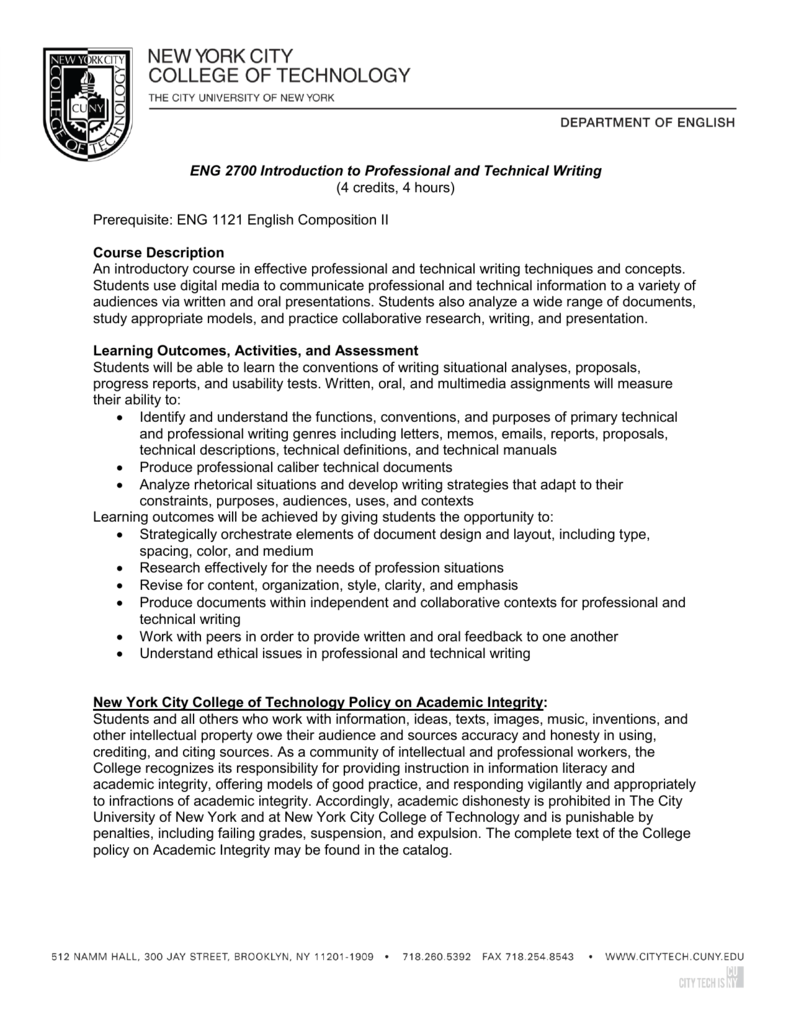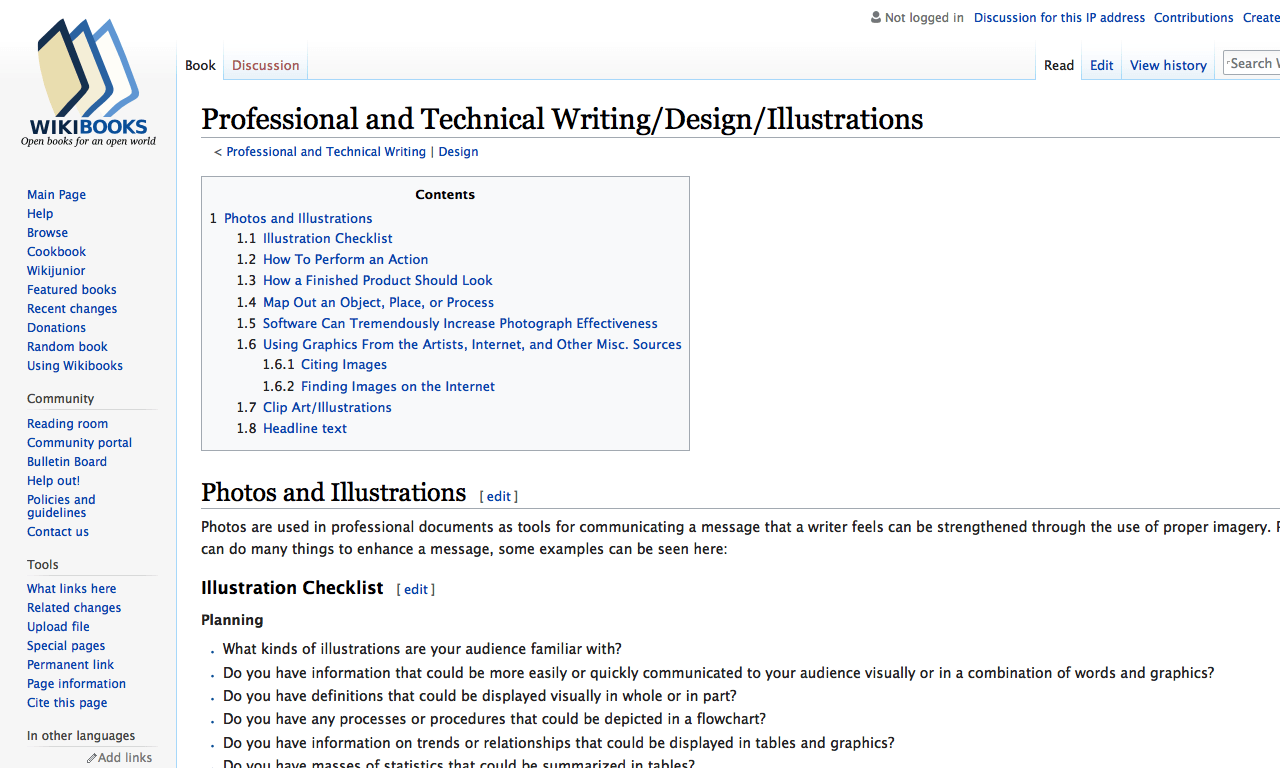
This textbook for professional and technical communication is a compilation of several Open Resource materials. The purpose in its design is to provide a wide variety of materials on subjects in professional and technical communication, and to offer several different perspectives and delivery modes of · While technical communication is essential in a wide range of fields and occupations, technical writing is also a fully professional field of its own with degree programs, certifications, and even theory. There are no fewer than five scholarly journals that are devoted completely or in part to publishing articles related to technical writing; what it is, how it works, how it is changing, and · Technical writing is a specialized form of exposition: that is, written communication done on the job, especially in fields with specialized vocabularies, such as science, engineering, technology, and the health sciences. Along with business writing, technical writing is often subsumed under the heading of professional blogger.comted Reading Time: 3 mins
Professional and Technical Writing | OER Commons
While many professionals do not see themselves as writers, their jobs require that they read and write quite often. While there are some differences highlighted below, generally understand that any of these combinations refers to presenting information to audiences with the ultimate purpose of getting work done.
This is a pretty broad definition, and in fact, the field is pretty broad itself. Technical communication is all around, professional and technical writing. If you consider technology as anything that applies scientific findings, then you will start seeing it everywhere.
While high technology like smart phones and wifi is becoming ubiquitous, low technology has been around since humans began crafting utensils. Technical writing might be the prescription written on the inside of frame of your eyewear, the label inside your shirt, or the caution sign outside of a construction site, professional and technical writing.
This kind of communication occurs constantly across institutions, including government sectors, hospitals, businesses, corporations, universities, etc. Unlike academic papers in which the goal is generally to develop an idea, make a professional and technical writing argument, or demonstrate competence, professional texts aim to persuade people with power to take a specific action.
These texts can be written, visual, or oral and print or electronic. To understand which text is most appropriate for a certain task, writers need to consider concepts of rhetoric like audience and contextual analysis as well as design principles.
This is a contested question in the field. The most basic definition of rhetoric might be reduced to the study of persuasion, or how words do things. In fact, professional and technical writing, Plato condemned the sophists for being deceitful rhetors Gorgias claimed that he could make any seemingly ridiculous argument seem sound.
While the study of argumentation may seem like an abstract and often philosophical debate, rhetorical moves can be observed in almost any interaction. Think of how you were persuaded to read this text, or the various factors that went into your decision about what to eat professional and technical writing not eat for breakfast this morning.
The art also considers elements like invention and delivery, which acknowledge all aspects of the writing process. From developing the idea for a project to publishing reports, professionals use rhetoric both deliberately and unconsciously. The first three are rhetorical appeals that Aristotle distinguished, and kairos is an idea of opportune time and place that was central to the sophistic school of thought.
Analyzing how these appeals function in texts can improve your ability to use them coherently to accomplish your purpose for your intended audience. Yes and no. On the one hand, professional and technical writing, the distinction of PTC as workplace writing as opposed to other genres of communication helps to define the field. However, all communication is inherently biased and situated in some way.
You might not tell your parents about a new tattoo the same way you would tell your friends. Similarly, you would not tell a colleague or professor in biomedical engineering how a new pacemaker works the same way that you would tell a surgeon or a patient. In making decisions about how to communicate information, professional and technical writing, writers must think about how their choices affect their audience, professional and technical writing.
Who is cut off from access to information? How does one choice privilege certain a demographic, a way of understanding, or one culture over another?
Does the publication or dissemination of texts unethically exclude certain people, professional and technical writing, preventing them from receiving information that would help them advance their careers or complete a task? Other, more basic questions about functionality rely on rhetorical choices: Does the text communicate adequate amounts of information without overwhelming the audience? Is it produced in a meaningful and useful way or will it go on to sit on a shelf and rarely be read?
These are all questions professional and technical writing influence the field and are important to people writing in professional roles. Technical writing takes place in collaborative environments. Multiple moving parts means that learning skills in working within groups and staying organized are important for getting and maintaining a career within an organization.
Whether you are an academic scientist, a business consultant, a mechanical engineer, or a patient care provider, you will need to understand good communication practices. Avoid unnecessary and time-consuming conflict by approaching projects with an open mind and with an awareness of your own biases, which might be different from not only those of your readers but also of your colleagues.
Collaboration tactics like project management will also benefit you in individual tasks. Currently, much technical writing happens through remote work, and as such, professional writers often work for multiple clients concurrently. In fact, one can make a pretty good living by working from home on a number of contracted or part-time jobs, but to be successful means to constantly balance tasks by developing a system for organizing them.
Because of the collaborative nature of this work as well as the natural process of writing, document review and revision are integral parts of producing written communication. While a large part of the field professional and technical writing writing, there are numerous other tasks associated with creating and distributing tasks.
Because their goal is often to create texts that help users complete tasks, professional and technical writing, technical writing professionals perform usability tests to determine how successful their text was and how to improve it before publication. Other elements of developing texts are graphic design, data visualization, and remediation recreating texts in various mediums for different audiences or purposes.
PTC professionals generally stay ahead of the curve when it comes to new technologies. Because technology is constantly evolving and new tools emerge daily, it would be impossible to master every relevant tool.
Instead, technical communicators master the analytic skills and foundations of systems in order to adapt to the changing environment of the field. Professionals who master skills in their own contexts, whether it is a hospital setting or a large corporation, will become familiar with certain procedures; for writing professionals, this means that they have preferred design and editing software for both print and electronic publishing, and knowing them well means that they can pick up client-preferred tools quite easily.
Design and content are complementary considerations. Sometimes, space limitations will mean that the writing needs to be extremely concise and stripped of all detail.
In either case, writers must consider their goals first and foremost. Conversely, space constraints might require writers to rethink sentence structure and voice. Writers have to consider audience values, the rhetorical situation they are in, and institutional constraints like cost and formatting, as well as accessibility. Different audiences will have different interpretations of texts based on their culture, priorities, and relationship to the topic.
Therefore, before beginning the task of writing, the composition process requires writers to consider professional and technical writing whom they are writing. In the workplace, there are often two audiences: internal, or inter-organizational, and external, which is often the public.
Skip to content Menu Subjects Site Map Collaboration Design Editing Genre Information Literacy Invention Organization Mindset Research Revision Rhetoric Style Writing Studies Writing with Sources. Dear Past Authors Contribute Feedback. Learning Outcomes: distinguish between technical and professional communication and writing understand the role of a technical communicator know how ethics, professional and technical writing, collaboration, context awareness, research, writing, and design connect in the creation of documentation Identify three artifacts of technical communication in the room.
What do they have in common? What differs? Do a job search on a popular outlet monster. com, local newspaper sites, stc. org, etc. for technical writers.
Then, based on the qualifications and tasks listed with jobs under each title, write a definition of each. What is Rhetoric? What Does a Technical Communication Work Environment Look Like? Do Professional and Technical Writers Just Write? Role of Technology PTC professionals generally stay ahead of the curve when it comes to new technologies.
Should I Start with Design or Writing First? List of Key Definitions Accessibility— the readability of a text for diverse users with diverse capabilities which may be physical, cognitive, monetary, cultural, professional and technical writing. Artifact— in technical communication, generally anything that counts as a final product, from a text document to an instructional audio clip to a website.
As opposed to a deliverable, an artifact is most often defined from a reader or public point of view, and it carries with it the element of chronos, or time, as something that is final and consumed at the time it is being referenced.
Audience Analysis— the process professional and technical writing researching the primary and secondary audiences in order to tailor deliverables to their needs and values.
Deliverable— the final product that is ready to be published, or the text that a writer plans to deliver to her client. This is usually a term used in the context of production and finalization; after publication, a deliverable might be considered an artifact but you might find these terms somewhat interchangeable. Repurposing— the process of professional and technical writing an original text and developing new sometimes multimodal or mixed media deliverables for different audiences or purposes.
Rhetorical Situation— the occasion, audience and constraints in which one is writing. Usability Testing— in technical communication, the act of bringing in users to try out tasks outlined in a text with the goal of discovering issues with the text before publishing it to the intended audience.
Exercises: Identify three artifacts of technical communication in the room. Suggest an edit to this page? Please share your feedback, both favorable and unfavorable. Please select the purpose of your message. This field is for validation purposes and should be left unchanged.
Technical \u0026 Professional Writing
, time: 5:22Chapter 1: Introduction – Technical and Professional Writing Genres [Beta]

Professional and Technical Writing Certificate Professional & Technical Writing Certificate Undergraduate students at FAU who wish to enhance their skills and experience in the field of professional writing should pursue the Professional and Technical Writing certificate Business Writing, Professional Writing, Technical Writing Unit 2 Understanding Your Audience Unit 3 Delivering Your Message Unit 4 The Writing Process Unit 5 Emails, Memos, Letters Unit 6 Employment Documents Unit 7 Proposals Unit 8 Reports Unit 9 Writing Clear Instructions Unit 10 Collaborative Writing and Working in Teams Unit 11 The Presentation The terms “professional” and “technical” as well as “writing” and “communication” are used fairly interchangeably in the field. While there are some differences highlighted below, generally understand that any of these combinations refers to presenting information to audiences with the ultimate purpose of getting work done. This is a pretty broad definition, and in fact, the Estimated Reading Time: 8 mins
No comments:
Post a Comment